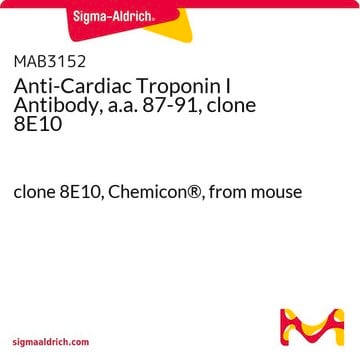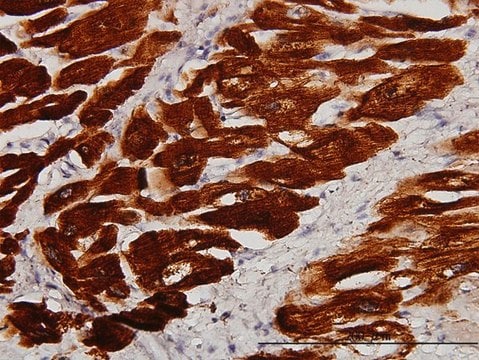SAB4200717
Anti-Troponin T antibody, Mouse monoclonal
clone JLT-12, purified from hybridoma cell culture
Synonyme(s) :
Anti-TNNT1, Anti-TNNT2
About This Item
Produits recommandés
Source biologique
mouse
Forme d'anticorps
purified from hybridoma cell culture
Type de produit anticorps
primary antibodies
Clone
JLT-12, monoclonal
Forme
buffered aqueous solution
Poids mol.
antigen ~38 kDa
Espèces réactives
rat, human, mouse, bovine, rabbit, goat
Concentration
~1.0 mg/mL
Technique(s)
immunoblotting: 0.5-1 μg/mL using rat skeletal muscle extract
immunofluorescence: suitable
immunohistochemistry: 5-10 μg/mL using heat-retrieved formalin-fixed, paraffin-embedded human skeletal muscle sections
Isotype
IgG1
Numéro d'accès UniProt
Conditions d'expédition
dry ice
Température de stockage
−20°C
Modification post-traductionnelle de la cible
unmodified
Informations sur le gène
human ... TNNT1(7138)
Description générale
Immunogène
Application
- Anti-Troponin T antibody, Mouse monoclonal has been used in:
- immunoblotting
- immunofluorescence
- immunohistochemistry
Actions biochimiques/physiologiques
Forme physique
Clause de non-responsabilité
Vous ne trouvez pas le bon produit ?
Essayez notre Outil de sélection de produits.
Code de la classe de stockage
10 - Combustible liquids
Classe de danger pour l'eau (WGK)
WGK 1
Point d'éclair (°F)
Not applicable
Point d'éclair (°C)
Not applicable
Certificats d'analyse (COA)
Recherchez un Certificats d'analyse (COA) en saisissant le numéro de lot du produit. Les numéros de lot figurent sur l'étiquette du produit après les mots "Lot" ou "Batch".
Déjà en possession de ce produit ?
Retrouvez la documentation relative aux produits que vous avez récemment achetés dans la Bibliothèque de documents.
Les clients ont également consulté
Notre équipe de scientifiques dispose d'une expérience dans tous les secteurs de la recherche, notamment en sciences de la vie, science des matériaux, synthèse chimique, chromatographie, analyse et dans de nombreux autres domaines..
Contacter notre Service technique









